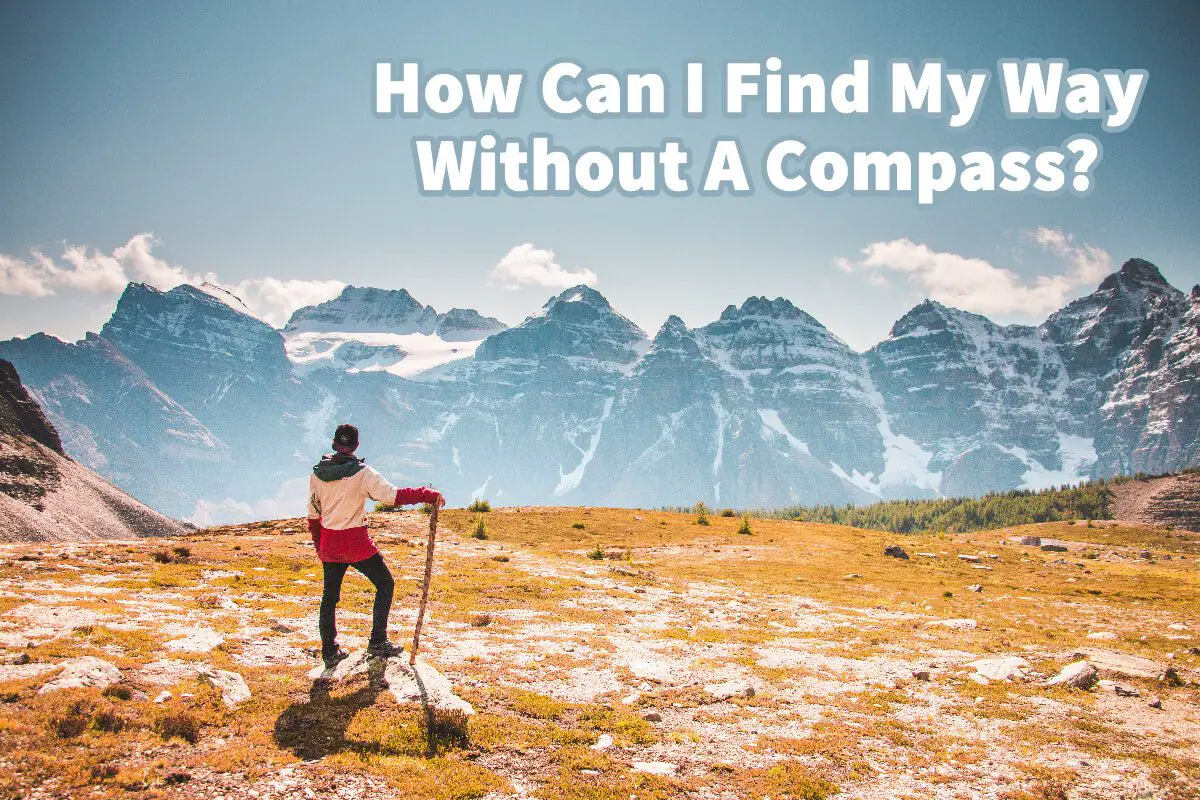If you are going to be sailing, hiking, or just being in the great outdoors, there may be times when you need to try to find your way without having a compass. For centuries our forefathers found their way without GPS or a compass.
You can find your direction even if you do not have a compass. You can use both the sun and the stars as your guide. You can also use the two sticks method at night and a day to help you find your direction. Also, just being an observer and understanding nature can help you find your way without a compass.
Use the Sun As Your Guide

The sun will rise in the east and set in the west; if it is morning, you can look at where the sun rises and know that it is east, and when the sunsets, you know it is west. The sun will rise in the east and set in the west no matter where you are.
Look at the sun during the highest point of the day; the sun will change according to your hemisphere. Here is how the direction of the sun during the highest point during the day will vary with the hemispheres and equator:
- Highest Point Of Sun – Northern Hemisphere – The sun’s highest point will be south in the Northern Hemisphere. So if you are in the Northern Hemisphere and see the sun at the highest point, you know it is south.
- Highest Point of Sun – Southern Hemisphere – In the Southern Hemisphere, the sun’s highest point will be north. So if you are in the Southern Hemisphere, you will know that the sun at the highest point during the day is in the north direction.
- Highest Point of Sun – the Equator – At the equator, the sun’s highest point is directly overhead. So you need to understand which side of the equator you are on to know if the direction is north or south.
The sun will also be higher in the summer than in the winter, so you need to consider whether it is winter or summertime.
By looking at the sun and where the sun is setting, rising, or the highest point of the day, you can discover the cardinal directions of north, east, south, and west. Knowing these directions lets you know what direction you are going or traveling.
Use the Stars As Your Guide

The wise men and shepherds followed the star to find the baby Jesus; travelers used the stars to guide them and their directions for thousands of years.
Here are some of the stars you need to look for:

- Find The Big Dipper – You can find the big dipper as the big dipper looks like a big scoop in the sky. It is one of the easier star constellations to find.
- Find The North Star – From the Big Dipper, look for a bright star lined up with the big dipper. That star is known as the north star. The north star will only move slightly in the sky with the other stars circling it.
Once you have found the North Star, you know you are facing and pointing north. The north star will always point directly to the north. That is why many times, it’s also called the Polaris Star.
Use The Two Sticks Method
There is also an ancient two sticks method that you can use to find your direction. This method will work both during the day and night.
Stick Method At Night
For the stick method to work at night, it should be a cloudless night. On a bright night, drive a stick into the ground until the tip of the stick is at your eye level.
Behind that stick, plant a taller stack so that the tips of the sticks line up onto a bright star. After a few moments, the stars will appear to start to move. But remember that the stars do not move, but the earth is rotating.
When you see the movement, remember the following:
- Movement Going Up – If you see the movement going up from the sticks, you are facing east.
- Movement Going Down – If you see the movement going down from the stick, you face west.
- Movement Going in Right – If you see the movement going right, you face south.
- Movement Going Left – If you see the movement going left, you face north.
Stick Method During The Day
This stick method for the daytime is slightly different than at night. Find a stick that is almost a foot tall. Poke the stick into the ground so that it is standing straight up.
Look for the shadows around the stick. Place a rock at the end of the shade cast by the stick. Wait about 15 minutes.
When 15 minutes have passed, put a rock at the end of the second shadow. Now you have your markers to find north.
With your back to the stick, stand with your left toe to touch the first rock and your right toe to touch the second rock. You are now facing north and should be able to find the other points of south, east, and west.
Use A Wristwatch To Find Your Way
If you happen to have a trusty analog wristwatch, you can use that watch to help you find your way. A smartwatch or digital watch will not work for this experiment.
Here is what you need to do:
- Place The Analog Watch On A Level Surface – Place the watch on a level surface.
- Point The Hour Hand Towards Sun – Then point the hour hands directly towards the sun. Find the imaginary line between the hour hand and the 12 on the watch face.
- Find South And North – The first imaginary line points south, and 180 degrees opposite would point north. From the north and south, you should be able to be found east and west.
Observe Nature To Find Your Way

One of the best things you can do is be an observer of nature and understand the nature around you. You can do this by the following:
- Look For Landmarks – Sometimes, you can find natural and manmade landmarks that can help you know the direction you need to go. If you live in the mountain areas, the mountains can become a landmark and show you where you should go.
- Look At Vegetation – You can also look at the vegetation around you. Deciduous trees or trees that change color and lose their leaves tend to grow on the south side as they like the sun. Evergreen trees such as pine usually like to grow on the north side.
- Moss On Trees – If you see moss on a tree in an open area and exposed to the sun, you can know that the tree is probably facing more north where the moss is growing as moss-to grow moss likes to have shade most of the day.
Whether you are out sailing, hiking, camping, or just out in nature on a nice summer day, you can use one or all these techniques to help you find your direction. There are so many beautiful things we can learn from nature, and when we understand these things, nature can help us find the right direction – even North, South, East, and West.
At A Bus On A Dusty Road, we talk about all things to do with travel, life, sailing, and ex-pat living. We are all about “Living Life As A Global Citizen.” We explore social, cultural, and economic issues and travel.
We would love to have you be part of our community. Sign up for our newsletter to keep up-to-date by clicking here. If you have any questions, you can contact me, Anita, by clicking here.
Listen to our Podcast called Dusty Roads. You can find it on all major podcast platforms. Try out to listen to one of our podcasts by clicking here.
Subscribe to our A Bus On A Dusty Road YouTube Channel filled with great videos and information.
Related Questions
125+ Travel and Leisure Inspirational Quotes
We love to travel and believe that we can learn so much from many other parts of the world. At A Bus On A Dusty Road, we believe we should all try “Living Our Life As A Global Citizen.”
Here are over 125 inspirational quotes about travel, life, and Leisure. These are some of our favorite quotes that help to inspire and remind us all about “Living Life As a Global Citizen.”
By clicking here, you can discover 125+ Travel and Leisure Inspirational Quotes.
What Should You Know Before Traveling Alone?
Traveling alone to explore a new destination is a fantastic experience. But before you travel, you should do things such as doing your homework to know all about your destination. You must also check out all the legal and visa requirements to ensure you have no issues with your travel plans. And finally, have at least the first few days of your travel planned out.
By clicking here, you can discover What You Should Know Before Traveling Alone?
6 Steps to Help You Travel Alone And Make A Ton Of New Friends
To travel alone and make friends, you must first learn to be alone and enjoy yourself. Smiling at other people can help to break the ice. Go up to talk to new people and get to know them. Be a good listener and get to know others. Don’t be afraid to try a new language. And finally, when you travel alone and start to make friends around the world, you quickly learn that there are many good people out there in this big wide world of ours.
By clicking here, you can discover 6 Steps to Help You Travel Alone And Make A Ton Of New Friends.


